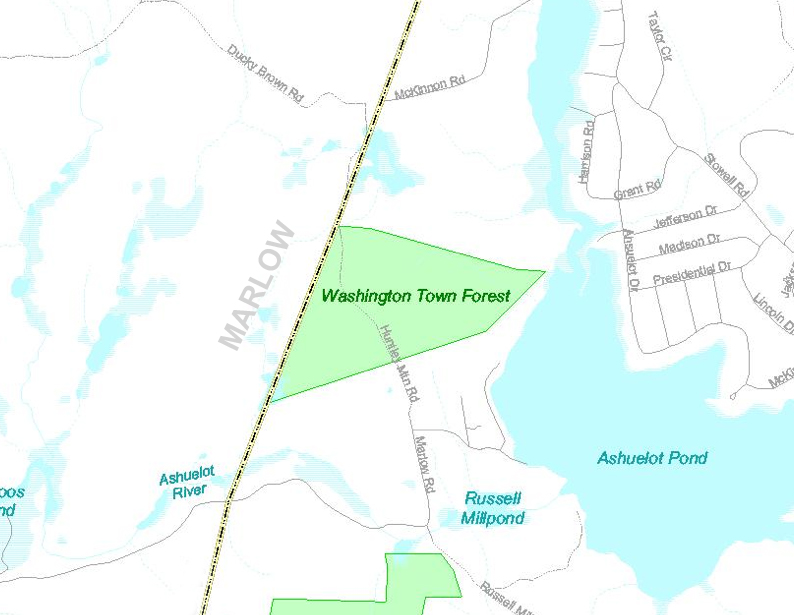|
The Huntley Mountain
Road property is located just west of Ashuelot Pond,
near the southwestern corner of Washington. Consisting of
106 acres, this property contains the summit and southern
half of a small unnamed hill overlooking Ashuelot Pond. There
are no conservation lands that adjoin this property, but its
proximity to Ashuelot Pond as a large and undeveloped tract
makes it an important conservation property in its own right.

Perhaps the most important wildlife habitat on the property
is the marsh in the south, where the abundance of water, sedges,
grasses, shrubs and snag trees combine to meet the needs of
many animals. Rocky slopes on and around the unnamed hill
are good for small rodents and the reptiles that eat them.
The forested habitat diversity is good in terms of tree species,
with areas of hemlock, red oak, sugar maple, red maple, and
spruce and fir forming distinct stands. The age-class distribution
of trees is less than ideal, however, with little to no young
stands or upland openings. A future timber removal should
include the provision at least one opening, preferably one-half
acre or more in size and away from Huntley Mountain Road.
There are seven management units
on the Huntley Mountain Road property:
1) MU 1 consists of two stands, one to the east and one to
the south of the unnamed hill. Both contain large sawtimber
sugar maple and red oak trees, with a mix of red oak, red
maple, sugar maple, white ash and white and yellow birch poles
below. The east side of this MU may pose problems in terms
of operability, as this area has some steeper slopes and rocky
areas.
2) MU 2 serves to separate the two stands of MU1 from each
other, then continuing to the south and to the north along
both sides of the road. MU2 has a large sawtimber canopy of
scattered white pine and red oak, with more numerous red maple
and red oak poles underneath.
3) MU 3 makes up the northeastern corner of the property,
and is dominated by fairly uniform red maple poles. There
is some red oak in this stand that should be favored in future
treatments. A 1-2 acre sphagnum wetland is also in this MU,
which must be avoided by harvesting activities.
4) MU 4 is one large stand of red oak, red maple and red spruce
in the southwest part of the property. Mostly poles, there
are some small and large sawtimber trees, but they are scattered.
5) MU 5 is a small to large sawtimber hemlock /red oak/red
spruce stand in the northeastern corner of the property. Overall
the stand is understocked, meaning that more trees are needed
to fully occupy the available growing space.
6) MU 6 is a stunted red oak and red maple pole stand on the
summit of the unnamed hill. These trees may be much older
than their small stature might suggest, as an earlier fire
appears to have robbed the site of much of its topsoil. Operability
will be a problem in this MU, as there is a fair amount of
exposed and jagged ledge.
7) MU 7 is inoperable due to steep slopes and very rocky terrain.
Heavy to spruce in the east and beech and red oak in the west,
this stand is a mix of poles and small sawtimber with an occasionally
larger tree.
|

